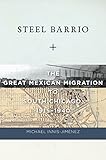Steel Barrio : The Great Mexican Migration to South Chicago, 1915-1940 / Michael Innis-Jiménez.
Material type: TextSeries: Culture, Labor, History ; 10Publisher: New York, NY : New York University Press, [2013]Copyright date: ©2013Description: 1 online resourceContent type:
TextSeries: Culture, Labor, History ; 10Publisher: New York, NY : New York University Press, [2013]Copyright date: ©2013Description: 1 online resourceContent type: - 9780814785850
- 9780814760437
- Immigrants -- Illinois -- Chicago -- Social conditions -- 20th century
- Mexican Americans -- Illinois -- Chicago -- History -- 20th century
- Steel industry and trade -- Illinois -- Chicago -- History -- 20th century
- Working class -- Illinois -- Chicago -- Social conditions -- 20th century
- HISTORY / Latin America / Mexico
- 305.896872077311 23
- F548.9.M5 I66 2016
- online - DeGruyter
| Item type | Current library | Call number | URL | Status | Notes | Barcode | |
|---|---|---|---|---|---|---|---|
 eBook
eBook
|
Biblioteca "Angelicum" Pont. Univ. S.Tommaso d'Aquino Nuvola online | online - DeGruyter (Browse shelf(Opens below)) | Online access | Not for loan (Accesso limitato) | Accesso per gli utenti autorizzati / Access for authorized users | (dgr)9780814760437 |
restricted access online access with authorization star
http://purl.org/coar/access_right/c_16ec
Since the early twentieth century, thousands of Mexican Americans have lived, worked, and formed communities in Chicago's steel mill neighborhoods. Drawing on individual stories and oral histories, Michael Innis-Jiménez tells the story of a vibrant, active community that continues to play a central role in American politics and society. Examining how the fortunes of Mexicans in South Chicago were linked to the environment they helped to build, Steel Barrio offers new insights into how and why Mexican Americans created community. This book investigates the years between the World Wars, the period that witnessed the first, massive influx of Mexicans into Chicago. South Chicago Mexicans lived in a neighborhood whose literal and figurative boundaries were defined by steel mills, which dominated economic life for Mexican immigrants. Yet while the mills provided jobs for Mexican men, they were neither the center of community life nor the source of collective identity. Steel Barrio argues that the Mexican immigrant and Mexican American men and women who came to South Chicago created physical and imagined community not only to defend against the ever-present social, political, and economic harassment and discrimination, but to grow in a foreign, polluted environment. Steel Barrio reconstructs the everyday strategies the working-class Mexican American community adopted to survive in areas from labor to sports to activism. This book links a particular community in South Chicago to broader issues in twentieth-century U.S. history, including race and labor, urban immigration, and the segregation of cities.
Mode of access: Internet via World Wide Web.
In English.
Description based on online resource; title from PDF title page (publisher's Web site, viewed 01. Nov 2023)


